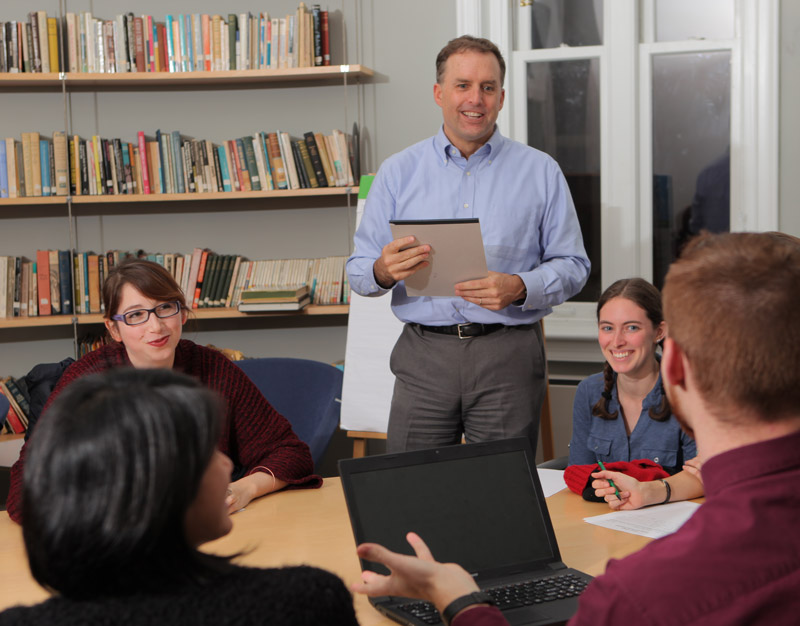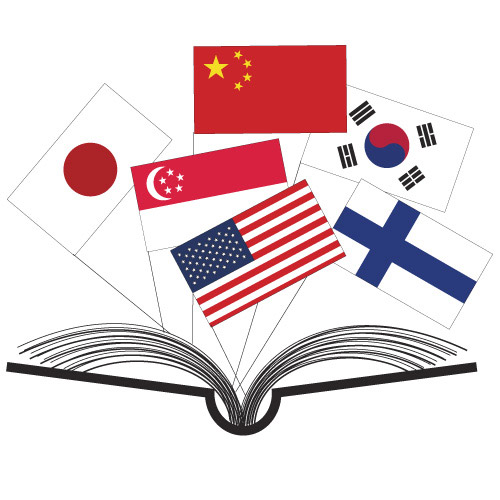Comparing Education
American Education is falling behind other countries on several critical measures, despite "high-stakes testing." Professor of education Chris Bjork asks: What can we learn from countries at the top of the lists?

Every three years, the Organization for Economic Cooperation and Development administers a test known as the Program for International Student Assessment (PISA) to half a million 15-year-olds worldwide in reading, mathematics, and science and publishes an analysis of the results. When the 2012 PISA results came out, U.S. Secretary of Education Arne Duncan was none too pleased. “The big picture of U.S. performance on the 2012 PISA is straightforward and stark: it is a picture of educational stagnation,” he said.
According to Duncan, the way forward is for the United States to learn from the top-performing systems—China, Singapore, and Korea—and to adopt their practices, including “high-stakes assessments,” the entrance exams for secondary and post-secondary education.
Chris Bjork, Professor of Education on the Dexter M. Ferry Jr. Chair, sees it differently. Bjork’s scholarly focus is comparative education, particularly the educational systems in Japan and Indonesia, but China and Korea as well. Before getting his doctorate in the anthropology of education at Stanford, Bjork spent a few years teaching elementary school in California and then several years teaching in Japan.
“Because of my experience as a classroom teacher, I’ve always been interested in the effects of education reform at the school level,” says Bjork. “Much of the comparative research looks at policy formulation in ministries of education, but there is not much research that closely examines the impact of those policies on teachers and kids and school communities.”
Over a period of six years, Bjork immersed himself in a sampling of Japanese elementary and middle schools, documenting what took place not only in classrooms but also on playgrounds, in hallways, and in teachers’ lounges. He interviewed students, parents, teachers, and administrators as well as Ministry of Education officials and scholars. His findings will be published in October by the University of Chicago Press under the title High-Stakes Schooling: What We Can Learn from Japan’s Experiences with Testing, Accountability, and Education Reform.
As U.S. policy makers are pushing for high-stakes assessments, policy makers in Japan and other Asian countries are instituting reforms to try to mitigate some of the negative effects of such policies. “China, Korea, Singapore, Indonesia, Vietnam—all of these countries are grappling with the same issues,” says Bjork. “In response to really strong criticism of the overemphasis on testing, these countries have introduced reforms to reduce pressure on kids, to make learning more engaging, to use more active, child-centered methods—all the things that we have historically excelled at but are now moving away from.”
Since the late 1950s, Japan has been at the forefront of test-driven pedagogy and by the 1980s had an educational system considered to be at the highest level of achievement, not only in terms of test scores, but other measures such as attendance and graduation rates. But in the late 20th century, the Ministry of Education began to respond to criticism that Japan’s schools were producing students who were deficient in areas not covered by the tests—critical thinking and creativity, for example. In 2002, the Ministry introduced reforms known as yutori kyoiku, or “relaxed education.” According to Bjork, these reforms have included shortening the school week to five days, revising the national curriculum to give students more academic freedom to follow their interests, and directing teachers to incorporate more student-centered methodologies in their teaching. “We need to reexamine this idea that the key to making schools better is to create more pressure on students and teachers,” he says.

What makes Japan such a great system to study, says Bjork, is that it is essentially two systems. “Up through the seventh grade, there is almost no testing, and the whole system is guided by teacher excellence and commitment to the craft of teaching. The learning is exciting and challenging and motivating, all at the same time. But once the students begin to feel the pressure of the exams they will have to take to get into high school, the goals of the system change completely. I’ve spent many, many days sitting in Japanese middle schools, and it’s just deathly for these kids who sit through classes where the sole purpose is to feed them facts that might appear on entrance exams.”
The “relaxed education” reforms have not had much of an impact, says Bjork, because the tests remain in place. “The tests have become so entrenched that many middle school teachers are hesitant to do anything that may cause their students to perform less well, and they’ve focused on test preparation so long that they don’t have the pedagogical skills to create the kind of student-centered investigations that the Ministry of Education is pushing for.”
At the elementary-school level, on the other hand, the teachers have always used the kinds of approaches advocated by the “relaxed education” reforms. “The elementary schools are doing an amazing job of keeping students engaged and making them all feel successful,” says Bjork. “I’ve visited classrooms that served families in poverty, communities where very low percentages of kids go on to college, but almost every single kid was supported in a way that they could feel successful and do well in school. So the elementary school teachers have it right. They know how to challenge their students academically and keep them committed to learning.”
The data support that conclusion. “If you look at international achievement test data, Japanese kids at the fourth-grade level excel in all subject areas,” says Bjork. “In the international math and science study, Japan has again and again scored at the very top—and those are the kids who are going to these elementary schools where testing is not emphasized and where the whole idea is that learning should be engaging and challenging at the same time. But when those same kids get to middle school, a gap emerges. As kids begin to experience the pressure of the looming exams, some of them rise to the challenge, while others learn very quickly that they are losers in the education game, so why should they try hard?”
So what is Bjork’s prescription for American schools? “If you look at Japanese elementary schools and also Finnish schools [Finland also ranks among the top on the PISA], one common theme is that an effective way to educational excellence is to hire the best possible people to become teachers in your schools and then give them a lot of autonomy and support and encourage them to continually look for ways to improve their craft. That will lead to higher test scores in a much more effective way than focusing on test prep.”
Bjork’s aim is to prepare his Vassar students to be that kind of teacher. “If I can give them the tools to change not necessarily what goes on at a national level, but at a school or district level—to me that’s invaluable.”
And they are out there, in the trenches. Sally Mayas ’08 is a first-grade special education teacher in an all-girls charter school in the South Bronx.
“Teaching in the current climate is an uphill battle,” says Mayas. “From my point of view, all of the issues stem from the larger issue of inequality. For example, schools in wealthier neighborhoods can opt out of the standardized tests with little or no repercussions. But if my school were to do that—we’re in the South Bronx, District 7 and 8, one of the poorest districts in New York City—we would be shut down. So testing in our community becomes disproportionately high-stakes.
“Last year, some Vassar students asked me, ‘How do you not get disheartened by the realities of the current situation in education in your day-to-day work?’ The important lesson I learned at Vassar was to not let yourself be tied down by the little things that affect teachers daily. Yes, there are tests, there is less recess time, there are awful outside factors working against your kids—but you can still do good work. As I recall, Chris always used to say, ‘Close your door and teach the way you know is best.’ ”
Bjork also says, “Education reform is a pendulum, and this test frenzy can’t last much longer. It’s already endured a lot longer than I expected, but in the last year or two, I’ve sensed that people are starting to organize and push back, and the government is finally starting to listen. But given the nature of these reform cycles, I think it’s really important for our students to develop a strong sense of what they believe education should look like, based on a careful study of practices in the U.S. and other countries, so that they have a rudder to guide them through these shifts in policy.”
What are the components of Japan’s “Relaxed Education” polities? Read an excerpt from Professor Chris Bjork’s book High-Stakes Schooling: What We Can Learn from Japan’s Experiences with Testing, Accountability, and Education Reform and find out.
